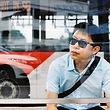
According to Mamiya, its 7ii is the tool of trade for professionals for its compact and lightweight traits on top of imagery perfection. Conversely, users of Mamiya 6 and 7 often describe them to be plasticky and brittle. Having this camera in my hands for the first time, it felt like none of those things. I guess in the world of medium format, being about the size of a Canon EOS 3 is considered small.
In regards to quality and body rigidity, it feels like a tank. Weights like one too. Soft rubber bits that wrap around the camera have not become sticky, no obvious scratch can be seen and none of it has come loose. Not bad for something twelve years of age. The external viewfinder too is rugged where exposed screws can be seen alongside a built-in spirit level, again very tool-like. My copy came with an original strap but sadly, no box and paper.
PRO
User friendly
Compact footprint
CON
Maximum aperture
SPECIFICATION
6 x 7 120 Rangefinder
Mamiya N MF
920 grams (body)
1376 grams (with 50mm)
From 2800 USD



The Mamiya 7ii is no fashion fad, it may be a cliche to describe it to be a beast but it really is an industrial purpose-built beast. Its power button, advance lever and cover release carries that feeling to operate. Moving onto its rotating knob, this is probably where most of the complaints are inspired by. Pulling to set film speed, pushing to select shutter speed and pressing for exposure compensation is not the slightest bit tactile. Either they are springy or it is the camera’s way of telling you to get lost.
As for N50mm f/4.5L, build is above average where it's made of metal except for the aperture ring and hood that’s plastic. Like the knob, it is flabby and does not click into place with satisfaction. Whoever’s responsible for these should have their retirement funds cut. To focus, it has a ninety degree throw that’s smooth and accurate.

Viewfinder is bright and filled with all the information you’d want nevertheless a bit small. I have little to no rangefinder know-how yet this one doesn’t stress me out as much. Like cameras of its type, minimum focus distance isn’t their strongest trait and the 7 is rated at one meter. Furthermore, focusing with a small patch in that big viewfinder is laughable. Just two things to keep in mind, take lens cap off prior to shooting and power off after use.

At 25 mm full frame equivalent, this setup is best suited for landscape photography however I doubt lugging 1.4 kilograms around the neck for hiking is a good idea. If lightweight is what you’re after in medium format, Fujifilm’s GA645 (60 mm standard) and GA645w (45 mm wide angle) are excellent choices at 815 grams. Besides, they are equipped with autofocus and open up to f/4.

Well, the Mamiya 7 wouldn't be good for nothing when one costs as much as it did in the nineties. For a start, its 50 mm glass suffers from no fringing and distortion at maximum aperture. We often hear of how sharp vintage Carl Zeiss lenses are but when compared to Mamiya’s, things seem over-credited. Spot metering may be of a concern however none of my Portra 400 negatives came back unusable. The biggest reason anyone buys a 7 is presumably for 6 by 7 negatives that’s four and a half times full frame. A format often regarded by photographers as the ‘ideal format’, good for serious cropping and poster printing.

When dark slide is closed, the shutter release does not fire. When open, a lock’s in place whereby the lens cannot be removed to prevent negatives from being exposed. In the field, these safety features come to use more than initially thought. Moving on, it only takes a single stroke (180 degree to be exact) to advance to the next frame which plays into Mamiya’s favour as some competitors require two. Although travel is long, the machine-like feedback is gratifying.

This combination though isn’t the place to start shooting rangefinders or film photography all together. Looking through its external viewfinder to compose the image then onto the in-body viewfinder to manual focus and then back to the external one to finalise your shot. For those not in the know, you’ll be regarded as an idiot. Enjoy the label while it lasts because it doesn’t take long to blast through a roll of 120.
If you’re not a seasoned Leica M shooter, I’d recommend going for either of Mamiya 7’s 65 or 80mm lenses as they work without needing an external viewfinder. I don’t usually mind going distance for quality but this honestly is some weight to lift. In spite of not being as quiet as mirrorless cameras, sound is sufficiently damped for most situations. The biggest drawback is that this will only work till its circuit boards give up as the Mamiya 7 requires one 4LR44 battery to power.

All that said, it does feel like a dream come true to experience one of, if not the best camera that ever lived. It is that grail camera and it's finally in my arsenal after a handful of lost auctions. I guess that makes the Mamiya 7ii all that more precious.
Shot on Mamiya 7ii paired to a 50mm f/4.5









.jpg)


